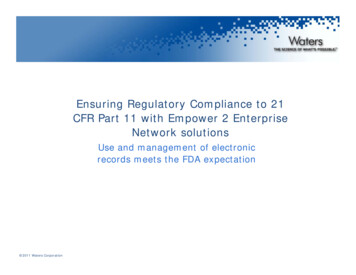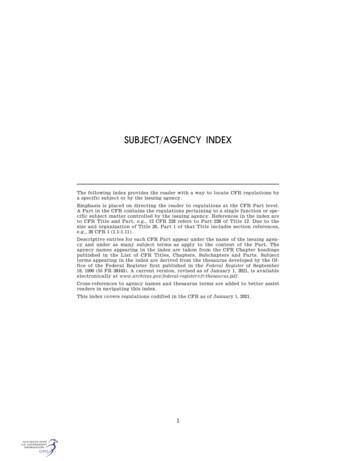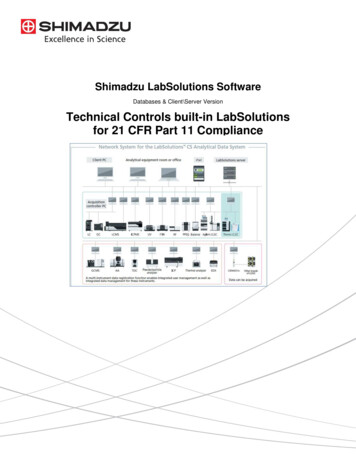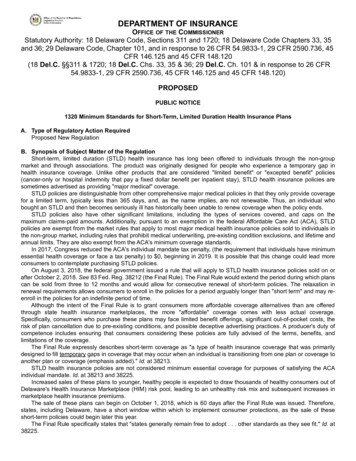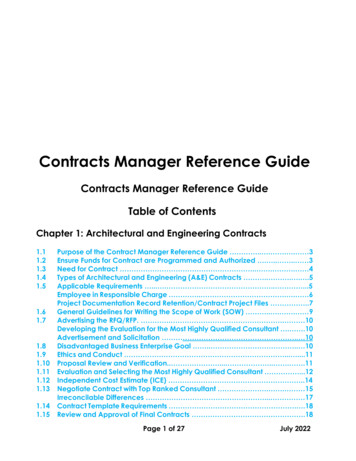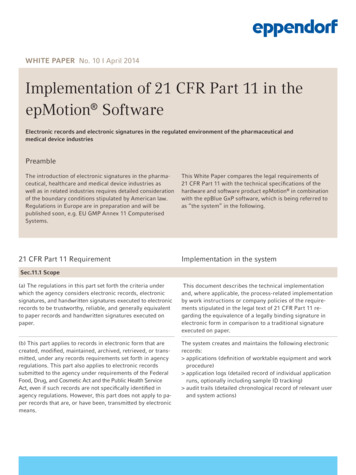
Transcription
WHITE PAPER No. 10 I April 2014Implementation of 21 CFR Part 11 in theepMotion SoftwareElectronic records and electronic signatures in the regulated environment of the pharmaceutical andmedical device industriesPreambleThe introduction of electronic signatures in the pharmaceutical, healthcare and medical device industries aswell as in related industries requires detailed considerationof the boundary conditions stipulated by American law.Regulations in Europe are in preparation and will bepublished soon, e.g. EU GMP Annex 11 ComputerisedSystems.21 CFR Part 11 RequirementThis White Paper compares the legal requirements of21 CFR Part 11 with the technical specifications of thehardware and software product epMotion in combinationwith the epBlue GxP software, which is being referred toas “the system” in the following.Implementation in the systemSec.11.1 Scope(a) The regulations in this part set forth the criteria underwhich the agency considers electronic records, electronicsignatures, and handwritten signatures executed to electronicrecords to be trustworthy, reliable, and generally equivalentto paper records and handwritten signatures executed onpaper.This document describes the technical implementationand, where applicable, the process-related implementationby work instructions or company policies of the requirements stipulated in the legal text of 21 CFR Part 11 regarding the equivalence of a legally binding signature inelectronic form in comparison to a traditional signatureexecuted on paper.(b) This part applies to records in electronic form that arecreated, modified, maintained, archived, retrieved, or transmitted, under any records requirements set forth in agencyregulations. This part also applies to electronic recordssubmitted to the agency under requirements of the FederalFood, Drug, and Cosmetic Act and the Public Health ServiceAct, even if such records are not specifically identified inagency regulations. However, this part does not apply to paper records that are, or have been, transmitted by electronicmeans.The system creates and maintains the following electronicrecords: applications (definition of worktable equipment and workprocedure) application logs (detailed record of individual applicationruns, optionally including sample ID tracking) audit trails (detailed chronological record of relevant userand system actions)
WHITE PAPER I No. 10 I Page 221 CFR Part 11 RequirementImplementation in the system(c) Where electronic signatures and their associated electronicrecords meet the requirements of this part, the agency willconsider the electronic signatures to be equivalent to fullhandwritten signatures, initials, and other general signings asrequired by agency regulations, unless specifically exceptedby regulation(s) effective on or after August 20, 1997.Electronic signatures executed in epBlue GxP meet all therequirements set forth in 21 CFR Part 11. The agency willconsider documents signed in this way to be legally equivalent to traditional handwritten signatures(d) Electronic records that meet the requirements of thispart may be used in lieu of paper records, in accordancewith 11.2, unless paper records are specifically required.Electronic records signed with the epMotion software maybe used in lieu of paper records, thus improving the workflow.(e) Computer systems (including hardware and software),controls, and attendant documentation maintained underthis part shall be readily available for, and subject to, FDAinspection.The hardware and software used to create the electronicsignature are made commercially available by Eppendorfand the system documentation is made available forinspection on request.Sec. 11.2 Implementation(a) For records required to be maintained but not submitted to the agency, persons may use electronic records inlieu of paper records or electronic signatures in lieu oftraditional signatures, in whole or in part, provided that therequirements of this part are met.(b) For records submitted to the agency, persons may useelectronic records in lieu of paper records or electronicsignatures in lieu of traditional signatures, in whole or inpart, provided that:(1) The requirements of this part are met; and(2) T he document or parts of a document to be submittedhave been identified in public docket No. 92S-0251 asbeing the type of submission the agency accepts inelectronic form. This docket will identify specificallywhat types of documents or parts of documents areacceptable for submission in electronic form withoutpaper records and the agency receiving unit(s) (e.g.,specific center, office, division, branch) to which suchsubmissions may be made. Documents to agency receiving unit(s) not specified in the public docket will not beconsidered as official if they are submitted in electronicform; paper forms of such documents will be consideredas official and must accompany any electronic records.Persons are expected to consult with the intended agencyreceiving unit for details on how (e.g., method of transmission, media, file formats, and technical protocols) andwhether to proceed with the electronic submission.The system provides means to create, digitally sign, andmaintain electronic records in compliance with this part.The electronic records provide a complete and traceabledocumentation of all actions performed on the system.
WHITE PAPER I No. 10 I Page 321 CFR Part 11 RequirementImplementation in the systemSec. 11.3 Definitions(a) The definitions and interpretations of terms containedinsection 201 of the act apply to those terms when used inthis part.(b) The following definitions of terms also apply to this part:(1) A ct means the Federal Food, Drug, and Cosmetic Act(secs. 201-903 (21 U.S.C. 321-393)).(2) Agency means the Food and Drug Administration.(3) B iometrics means a method of verifying an individual’sidentity based on measurement of the individual’sphysical feature(s) or repeatable action(s) where thosefeatures and/or actions are both unique to that individualand measurable.The system does not make provision for biometrics.Typing of user ID and password are used for identification.(4) Closed system means an environment in which systemaccess is controlled by persons who are responsible forthe content of electronic records that are on the systemThe system is configured as a closed system and meetsthese requirements. Access to the system is configured byits user management feature. All data are held in an industry standard database that is only accessible through thesystem’s software. The system can operate in corporatenetworks only for data exchange processes(5) Digital signature means an electronic signature basedupon cryptographic methods of originator authentication, computed by using a set of rules and a set ofparameters such that the identity of the signer and theintegrity of the data can be verified.The system uses a digital signature which employs cryptographic methods to verify the identity of the signer. Thisallows the identity of the signer and the integrity of data tobe recognized.(6) Electronic record means any combination of text, graphics,data, audio, pictorial, or other information representation in digital form that is created, modified, maintained,archived, retrieved, or distributed by a computer system.All electronic records defined here can be saved andretrieved in accordance with agency and legal requirements through the use of electronic signatures.The PDF format is used for long-term archiving.(7) Electronic signature means a computer data compilationof any symbol or series of symbols executed, adopted,or authorized by an individual to be the legally bindingequivalent of the individual’s handwritten signature.The system stores electronic signatures in its databasewith the records that have been signed. When exportingelectronic records as PDF files, the electronic signaturesare embedded as encrypted code that can be verified withappropriate software (such as Adobe Reader).
WHITE PAPER I No. 10 I Page 421 CFR Part 11 RequirementImplementation in the system(8) Handwritten signature means the scripted name or legalmark of an individual handwritten by that individualand executed or adopted with the present intention toauthenticate a writing in a permanent form. The act ofsigning with a writing or marking instrument such as apen or stylus is preserved. The scripted name or legalmark, while conventionally applied to paper, may also beapplied to other devices that capture the name or mark.The system does not make provision for handwritten signatures.Electronic handwritten signature capture devices arenot supported. However, all records can be printed andmanually signed on paper.(9) O pen system means an environment in which system access is not controlled by persons who are responsible forthe content of electronic records that are on the system.The system is designed as a closed system.Subpart B – Electronic RecordsSec. 11.10 Controls for closed systems.Persons who use closed systems to create, modify, maintain,or transmit electronic records shall employ procedures andcontrols designed to ensure the authenticity, integrity, and,when appropriate, the confidentiality of electronic records,and to ensure that the signer cannot readily repudiate thesigned record as not genuine. Such procedures and controlsshall include the following:The system supports users and agencies in fulfilling theserequirements by the following ways:(a) Validation of systems to ensure accuracy, reliability,consistent intended performance, and the ability to discerninvalid or altered records.The system has been audited to comply with the relevantrequirements of: I SO 62304 Class B(Medical device software – software life cycle processes) 21 CFR § 820 (Quality system regulation) G AMP5 Categories 3 and 4 and supports validationaccording to these requirements.The system is supplied with the appropriate certificates ofconformity.(b) The ability to generate accurate and complete copies ofrecords in both human readable and electronic form suitable for inspection, review, and copying by the agency. Persons should contact the agency if there are any questionsregarding the ability of the agency to perform such reviewand copying of the electronic records.The agency can use the system software, as well as anyother PDF display programs, to view the audit-proof datain human readable form on a screen or a printer. A mastercertificate is provided for PDF viewer software to verifyand check whether the data was generated by the system.The FDA explicitly stipulates the use of PDF for long-termarchiving.
WHITE PAPER I No. 10 I Page 521 CFR Part 11 RequirementImplementation in the system(c) Protection of records to enable their accurate and readyretrieval throughout the records retention period.The system ensures protection of records in the followingways: All records are stored in an industry standard database Data integrity of the records is ensured via checksum. Database backup function Archiving and export of records as signed PDF files(d) Limiting system access to authorized individuals.The system provides its own user management, allowingthe assignment of user rights to limit access to authorizedindividuals only. Password protection is enforced.(e) Use of secure, computer-generated, time-stamped audittrails to independently record the date and time of operatorentries and actions that create, modify, or delete electronicrecords. Record changes shall not obscure previously recorded information. Such audit trail documentation shall beretained for a period at least as long as that required for thesubject electronic records and shall be available for agencyreview and copying.The system automatically creates a continuous audit trailcontaining the time stamp and user name of all actionsperformed (like signing, creating new revisions, archiving,etc.) on electronic records. The audit trail is protected frommanipulation by administrators or users.The system provides revision control for user modifiablerecords (applications). Records are never permanentlydeleted or overwritten. All revisions can be viewed andexported from the system at any time.(f) Use of operational system checks to enforce permittedsequencing of steps and events, as appropriate.The system enables administrators to configure the processof signing records, e.g. how many signatures by which users and in which sequence are necessary for a record to beauthorized.(g) Use of authority checks to ensure that only authorizedindividuals can use the system, electronically sign a record,access the operation or computer system input or outputdevice, alter a record, or perform the operation at hand.The administrator can assign user rights incl. signaturerights. This ensures that only authorized users can electronically sign a record.(h) Use of device (e.g., terminal) checks to determine, as appropriate, the validity of the source of data input oroperational instruction.The system is delivered as a completely manufacturer qualified and documented package. Service and maintenanceagreements for re-qualification can be concluded.(i) Determination that persons who develop, maintain, oruse electronic record/electronic signature systems havethe education, training, and experience to perform theirassigned tasks.The hardware and software developers of the system arecertified for the necessary qualifications.Users and system administrators must receive training(provided by Eppendorf) to ensure correct system operationin accordance with legal requirements.(j) The establishment of, and adherence to, written policiesthat hold individuals accountable and responsible for actions initiated under their electronic signatures, in orderto deter record and signature falsification.Users and system administrators must receive appropriatelegal training and shall be obligated by signature toexecute electronic signatures in compliance with theapplicable laws analog to handwritten signatures. It isrecommended to document this e.g. in an SOP (StandardOperating Procedure).
WHITE PAPER I No. 10 I Page 621 CFR Part 11 RequirementImplementation in the system(k) Use of appropriate controls over systems documentationincluding:Each version of the system is supplied with the relevantsystem information provided with version numbering.All changes are subject to a defined change control anddocumentation process.In addition, the system can record changes made to itscomponents.(1) Adequate controls over the distribution of, access to, anduse of documentation for system operation and maintenance.(2) Revision and change control procedures to maintain anaudit trail that documents time-sequenced developmentand modification of systems documentation.Sec. 11.30 Controls for open systems.Persons who use open systems to create, modify, maintain,or transmit electronic records shall employ procedures andcontrols designed to ensure the authenticity, integrity, and,as appropriate, the confidentiality of electronic records fromthe point of their creation to the point of their receipt. Suchprocedures and controls shall include those identified in11.10, as appropriate, and additional measures such as document encryption and use of appropriate digital signaturestandards to ensure, as necessary under the circumstances,record authenticity, integrity, and confidentiality.The system supports users in ensuring authenticity and integrity by embedding a digital signature in records exportedas PDF files. The signature can be verified using standardsoftware like Adobe Reader.Sec. 11.50 Signature manifestations.(a) Signed electronic records shall contain informationassociated with the signing that clearly indicates all of thefollowing:(1) The printed name of the signer;(2) T he date and time when the signature was executed; andSigned electronic records in the system contain thefollowing information:(1) The printed name of the signer.(2) The date and time when the signature was executed.(3) The meaning associated with the signature.Upon signing, electronic records attain one of the states“created”, “reviewed” or “authorized” depending on thenumber of signatures and the signer’s role.(3) T he meaning (such as review, approval, responsibility, orauthorship) associated with the signature.(b) The items identified in paragraphs (a)(1), (a)(2), and(a)(3) of this section shall be subject to the same controlsas for electronic records and shall be included as part ofany human readable form of the electronic record (such aselectronic display or printout).The system enforces the same control for the informationassociated with electronic signatures by encrypted storagein the record. This information can be displayed in humanreadable form in the electronic record and the printout.
WHITE PAPER I No. 10 I Page 721 CFR Part 11 RequirementImplementation in the systemSec. 11.70 Signature/record linking.Electronic signatures and handwritten signatures executedto electronic records shall be linked to their respectiveelectronic records to ensure that the signatures cannot beexcised, copied, or otherwise transferred to falsify an electronic record by ordinary means.The electronic signatures generated by the system are savedas inseparably embedded into the document. This preventscopying and disclosure of signatures, as well as falsificationof electronic records.Subpart C – Electronic SignaturesSec. 11.100 General requirements.(a) Each electronic signature shall be unique to oneindividual and shall not be reused by, or reassignedto, anyone else.The electronic signatures generated with the system areunique and are related to the signing user’s account.The system ensures that user names are unique (and alsocannot be reused after deletion of a user account).(b) Before an organization establishes, assigns, certifies, orotherwise sanctions an individual’s electronic signature, orany element of such electronic signature, the organizationshall verify the identity of the individual.The customer is instructed to verify the identity of all persons who are authorized to execute an electronic signature.(c) Persons using electronic signatures shall, prior to or atthe time of such use, certify to the agency that the electronicsignatures in their system, used on or after August 20, 1997,are intended to be the legally binding equivalent of traditional handwritten signatures.The customer is instructed to certify to the agency (FDA)that electronic signatures are the legally binding equivalentof traditional handwritten signatures with the followingwording: “Pursuant to Section 11.100 of Title 21 of the Codeof Federal Regulations, this is to certify that [nameof organization] intends that all electronic signaturesexecuted by our employees, agents, or representatives,located anywhere in the world, are the legally bindingequivalent of traditional handwritten signatures.”(1) The certification shall be submitted in paper form andsigned with a traditional handwritten signature, to theOffice of Regional Operations (HFC-100), 5600 FishersLane, Rockville, MD 20857.(2) Persons using electronic signatures shall, upon agencyrequest, provide additional certification or testimonythat a specific electronic signature is the legally bindingequivalent of the signer’s handwritten signature.
WHITE PAPER I No. 10 I Page 821 CFR Part 11 RequirementImplementation in the systemSec. 11.200 Electronic signature components and controls.a) Electronic signatures that are not based upon biometricsshall:(1) Employ at least two distinct identification componentssuch as an identification code and password.The system requires identification by user name andpassword.(i) W hen an individual executes a series of signings during asingle, continuous period of controlled system access,the first signing shall be executed using all electronicsignature components; subsequent signings shall be executed using at least one electronic signature componentthat is only executable by, and designed to be used onlyby, the individual.(ii) When an individual executes one or more signings notperformed during a single, continuous period of controlled system access, each signing shall be executedusing all ofThe system always requires both user name and passwordto execute a signature.(2) Be used only by their genuine owners; andThe system enforces password complexity policies.(3) Be administered and executed to ensure that attempteduse of an individual’s electronic signature by anyoneother than its genuine owner requires collaboration oftwo or more individuals.It is in the customer’s responsibility to ensure that theAdministrator access to the system is protected and thatthe system’s administration is performed by trustablepersons. The customer is advised to establish rules (e.g.through an SOP), that the affected user has to be presentwhile an administrator changes or resets his or her password.(b) Electronic signatures based upon biometrics shall be designed to ensure that they cannot be used by anyone otherthan their genuine owners.The system does not support biometric identification.
WHITE PAPER I No. 10 I Page 921 CFR Part 11 RequirementImplementation in the systemSec. 11.300 Controls for identification codes/passwords.Persons who use electronic signatures based upon use ofidentification codes in combination with passwords shallemploy controls to ensure their security and integrity.Such controls shall include:(a) Maintaining the uniqueness of each combined identification code and password, such that no two individuals havethe same combination of identification code and password.The system ensures that user names are unique.(b) Ensuring that identification code and password issuancesare periodically checked, recalled, or revised (e.g., to coversuch events as password aging).The system enables administrators to define periods ofvalidity for passwords and user accounts.(c) Following loss management procedures to electronicallydeauthorize lost, stolen, missing, or otherwise potentiallycompromised tokens, cards, and other devices that bear orgenerate identification code or password information, andto issue temporary or permanent replacements using suitable, rigorous controls.The system enables administrators to lock user accountsto prevent use of compromised credentials. Administratorsalso can reset user passwords.The system does not support using tokens, cards and similar devices.(d) Use of transaction safeguards to prevent unauthorizeduse of passwords and/or identification codes, and to detectand report in an immediate and urgent manner any attemptsat their unauthorized use to the system security unit, and, asappropriate, to organizational management.A user account is automatically locked after threeunsuccessful login attempts.The system automatically displays the timestamp of auser’s last login.(e) Initial and periodic testing of devices, such as tokens orcards, that bear or generate identification code or passwordinformation to ensure that they function properly and havenot been altered in an unauthorized manner.The system does not support using tokens, cards andsimilar devices.The user is advised to make sure that the system’s computer is kept clean of any software programs that may beused to intercept input of user names and passwords.This may be accomplished by limiting access rights andusing appropriate anti-virus software.Your local distributor: www.eppendorf.com/contactEppendorf AG · 22331 Hamburg · GermanyE-mail: eppendorf@eppendorf.comwww.eppendorf.comEppendorf , the Eppendorf Logo and epMotion are registered trademarks of Eppendorf AG, Hamburg, Germany.All rights reserved, including graphics and images. Copyright 2010-2014 by Eppendorf AG.
21 CFR Part 11 Requirement Implementation in the system Sec. 11.3 Definitions (a) The definitions and interpretations of terms contained insection 201 of the act apply to those terms when used in this part. (b) The following definitions of terms also apply to this part: (1) Act means the Federal Food, Drug, and Cosmetic Act
